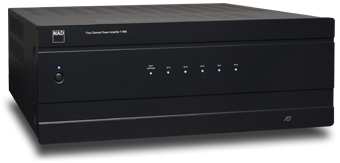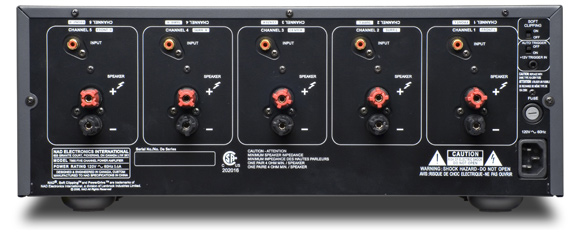
|

NAD
T955
Multichannel Power Amplifier

|
|
|
 |

DescriptionModel:
T955
Price: $1499.99 USD
Dimensions: 17.125"W x 6.125"H x 15.125"D
Weight: 45 pounds
Warranty: Two years parts and labor |

Features
- Rated at 100W x 5, all channels driven, into 8 or 4 ohms
- Rated dynamic power of 150W into 8 ohms, 200W into 4 ohms,
260W into 2 ohms
- Custom-wound Holmgren toroidal transformer
- NAD Soft Clipping circuitry
- NAD PowerDrive Circuitry
- Five-way binding posts
|
The most economical way to get into home
theater is to buy an audio/video receiver. The advantages of a receiver over separate
components is that the former includes all of the latest features, such as HDMI 1.3a to
connect Blu-ray or HD DVD players, and digital codecs such as Dolby TrueHD or DTS-HD
Master Audio. The drawback is that seven channels of amplification are stuffed into the
same box as the preamplifier-processor. As you can imagine, compromises must be made to
conserve space, and so transformers and capacitors -- a power amp’s most important
components -- tend to be smaller. Although most companies brag that their receivers will
put out, say, 120Wpc, it’s a numbers game -- it’s best to take receivers’
watts-per-channel ratings with a good pinch of salt.
One of the more solid choices you could make to your
newfangled receiver that plays everything and has every connection known to man is to add
a power amplifier. A great example is NAD’s T955 ($1499.99). The T955’s five
channels of amplification may be rated at only 100W each, but when comparing receivers to
dedicated amplifiers, watts aren’t watts.
Guts
For eons, NAD has been making amplifiers that are solid,
rarely break, and can drive nearly any loudspeaker without problem. The T955 continues
NAD’s conservative tradition by offering 100Wpc, all channels driven, from 20Hz to
20kHz, with less than 0.03% total harmonic distortion. Ask a maker of A/V receivers if one
of his products will do that, and he probably won’t look you in the eye, or
he’ll have all fingers and toes crossed when he says "Yes." Other solid
specs are those of the T955’s dynamic power output: 150W into 8 ohms, 200W into 4
ohms, and 260W into 2 ohms. No receiver I’m aware of can touch that 2-ohm output;
even many dedicated power amps can’t handle such a load.
NAD claims that the T955 is like five monoblock amplifiers
in a single chassis. This is mostly true, except for one thing: instead of five smaller
transformers, a single, massive Holmgren toroidal transformer is responsible for producing
the 80 amps of current that allow the T955 to easily drive those difficult 2-ohm loads.
The Holmgren also accounts for much of the T955’s 45 pounds.
The secret behind the T955’s ability to drive
difficult loads is NAD’s PowerDrive circuitry. According to NAD, PowerDrive is a
second high-voltage rail on the power supply that can double the amp’s output for
brief periods. Think of it as nitrous-oxide injection for your hot rod that you don’t
have to flick a switch to take advantage of -- PowerDrive kicks in automatically when
needed.
Looking through the ventilation slits in the top panel, I
could see all five amp modules lined up vertically, with heatsinks and no evidence of
cooling fans. When the T955’s front-panel On button is pushed, five blue LEDs light
up to let you know that all channels are working. Around back are five sets of RCA input
jacks, and as many pairs of five-way binding posts for connection to your speakers. A
toggle switch selects between allowing the T955 to be turned on from its front pushbutton
or from a 12V trigger. Another toggle activates Soft Clipping, which NAD claims rounds off
the output waveform when the T955 is driven hard enough to clip -- i.e., distort --
thus protecting your speakers. It’s great to have this feature when the guys are over
and you want to play air guitar to AC/DC’s "You Shook Me All Night Long."

Glory
Setting up the NAD T955 was so easy that my mom could do
it: unpack the 45-pound amp (she’s a strong woman), place it on the floor, use
RCA-terminated interconnects to hook it up to the receiver, connect the five speakers to
the amp’s binding posts, and turn it on. (Thanks, mom!) Then I sat down to watch a
bunch of DVDs.
The speakers I primarily used were the Paradigm Cinema 330
system, comprising Cinema 330s for front and center duties and Cinema ADPs as surrounds. A
Paradigm UltraCube 10 subwoofer took care of the bass. Because the NAD T955 sounded
cleaner, with more control over the speakers, than the amps in my Sony STR-DA5ES receiver,
I used the Sony to set the crossover point to a lower frequency so that more of the sound
was produced by the speakers instead of the sub.
Although the Cinema 330 system isn’t particularly
difficult to drive, the effects of using the NAD T955 instead of only the Sony were
startlingly immediate. A good example was just after the opening scene of Mission:
Impossible III, when the M:I theme breaks in with military-style drumming.
Through the Sony plus NAD, the drumming sounded tighter and sharper, rather than the more
relaxed, less distinct sound of the Sony alone.
Another area in which the T955 made a difference was the
midrange; dialogue had greater clarity than when I used only the receiver. No amount of
money spent on amplification, source components, or processing can clear up the mumbling
of Sylvester Stallone in Rocky Balboa, but the dialogue was much cleaner through
the NAD. Although I still had to pay close attention to understand Sly, I spent less time
hitting the remote’s Subtitles button. This can likely be attributed to the
NAD’s higher-quality components and circuits, as well as to being able to set the
crossover point lower with the NAD T955. Also, the noise floor in my system was a lot
quieter through the NAD; as a result, dialogue was coherent even at lower volumes -- or as
coherent as Rocky can be.
With the T955, I found myself playing my system louder
without realizing it -- while I was watching the DVD of Miami Vice, my wife popped
her head into the room to ask me to turn the volume down. This was no doubt because clean
power is less fatiguing, and the T955’s distortion ratings are far lower than my
receiver’s. At high volumes, the highs didn’t sound brittle through the NAD, as
they do when I crank up the Sony.
Watching DVDs didn’t give me a sense that the NAD T955
was better or worse at channel separation than the amps in the Sony. Effects such as those
in the race scenes in Cars, with sounds panned around the room, sounded pretty much
the same -- except that they were tighter through the T955. Music-only multichannel
recordings were a different story. In "Yesterday," from the DTS edition of Boyz
II Men’s II [CD, DTS Entertainment 1280786-1001], each member of the group is
placed in one of the five channels. I felt that each voice was better isolated at its
individual speaker with the NAD T955. This subtle but audible difference made for a better
listening experience.
Comparison
I’ve always thought of my Sony STR-DA5ES receiver as
an excellent pre-pro looking for an excellent power amp. Its DSP modes for movies provide
subtle but very good enhancements of the straight Dolby Digital and DTS surround formats.
The Sony’s feature set, which includes 7.1- and 5.1-channel inputs for my JVC
DVD-Audio player and Sony SACD player, is pretty good, if now somewhat dated. What greatly
enhanced my ability to enjoy the Sony was the addition of Anthem’s MCA 30, a 180Wpc
three-channel amplifier, which I use for the three front channels. The Anthem provided a
good point of comparison with the NAD T955.
One thing I love about the MCA 30 is Anthem’s patented
auto On/Off feature: the amp remains off until it senses a signal. Another feature the NAD
T955 lacks but that’s present on the Anthem are balanced inputs, which provide even
lower noise levels if you have a balanced pre-pro. Both amps have massive toroidal
transformers and huge internal heatsinks.
I’m not a huge believer in wildly varying amp sound
from competently designed amps, of which the Anthem and NAD are two great examples. What
goes into a power amp should come out louder, without being altered in any other way --
that’s what a preamp’s tone controls are for. While watching Cars,
however, I thought the Anthem sounded tonally darker, with deeper bass than the NAD. The
T955’s highs, in comparison, sounded airier than the Anthem’s. This difference
in tonality wasn’t something I’d normally notice while listening to either amp
on its own, but it jumped out at me when I compared them head to head.
Conclusion
The NAD T955 should be a great addition to any home-theater
system. Not only will it work well with a preamplifier-processor, but using it with a
receiver is an excellent way to upgrade a system without breaking the bank. If your
speakers present difficult loads to drive, an amplifier such as the T955 would be terrific
for your system. For about a year now, I’ve gotten great results from the pairing of
Anthem’s MCA 30 three-channel amp and Sony’s STR-DA5ES receiver; the NAD T955
performed equally well. My only complaint about the NAD is its lack of a signal-sensing
automatic turn-on feature (the remedy is to use the 12V trigger). That aside, I’ve
wowed my friends and myself with the awesome control this dedicated power amplifier amp
has had on my loudspeakers.
| Review
System |
| Speakers - Paradigm Cinema
330 (mains, center), Cinema ADP (surrounds), UltraCube 10 (subwoofer) |
| Sources
- Pioneer Elite PD-65 CD player, JVC XV-721 and Sony DVP-NS975 DVD players |
| Receiver - Sony STR-DA5ES |
| Amplifier
- Anthem MCA 30 |
| Cables - Sonic Horizons,
TARA Labs, Nordost, Python |
| Display
Device - Sanyo PLV-Z5 front projector |
|
|

